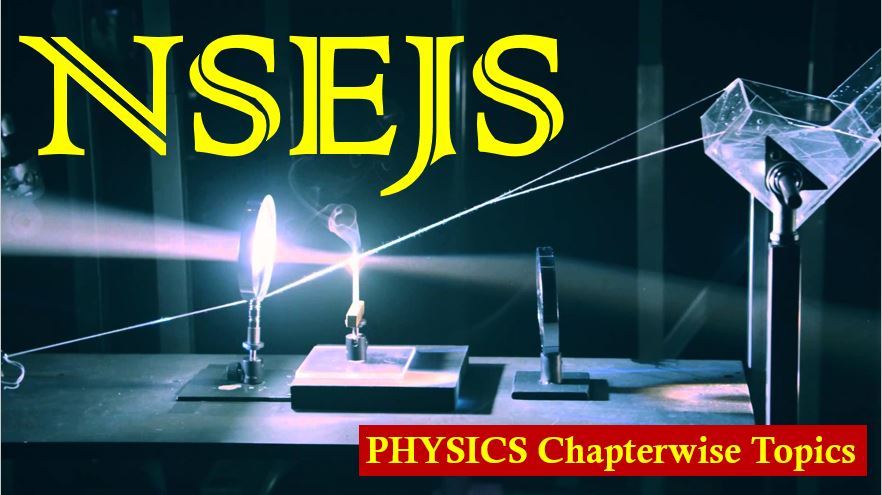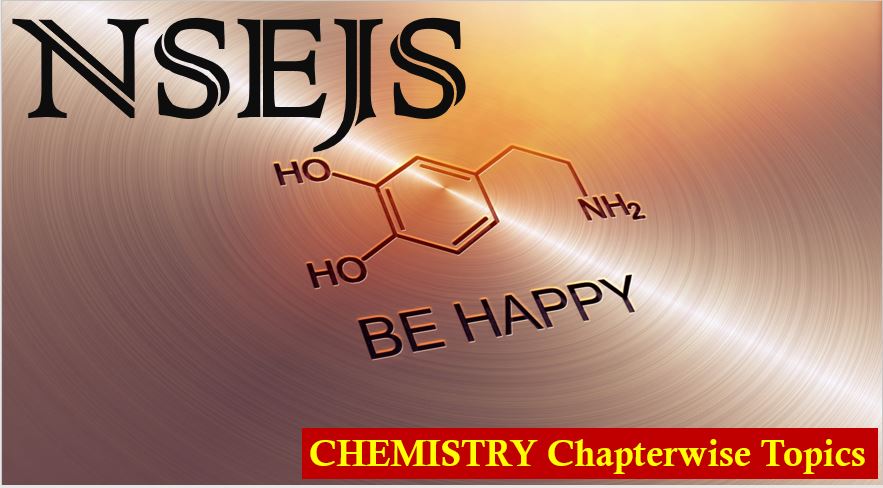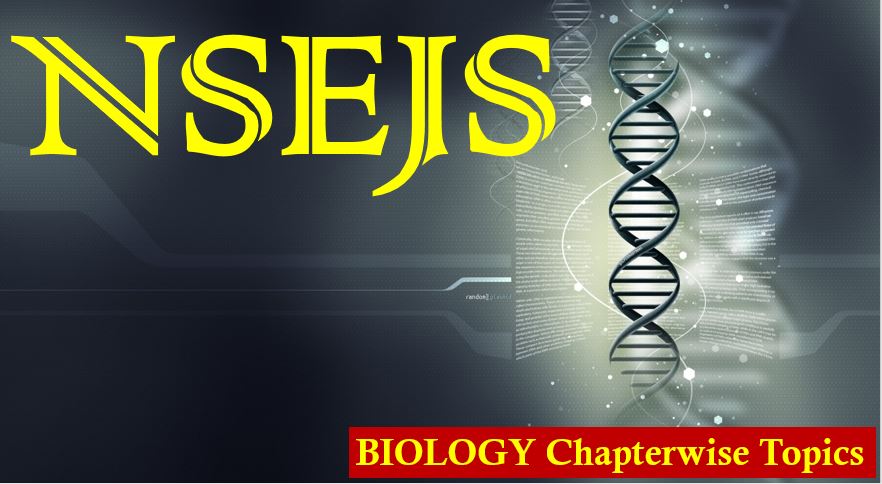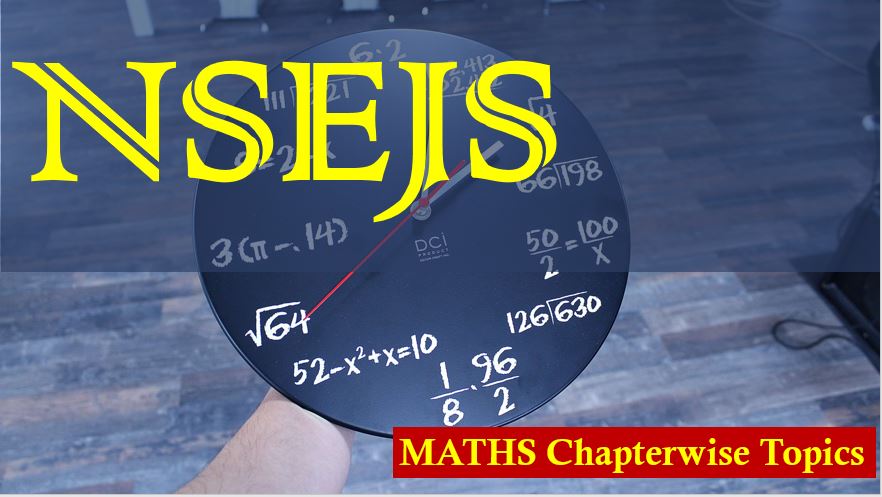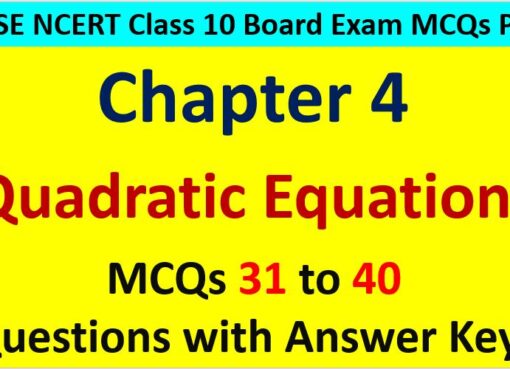NSEJS Syllabus 2020 Physics Chemistry Mathematics Biology Chapterwise Topics
Hi students, Welcome to Amans Maths Blogs(AMB). In this post, you will get NSEJS Syllabus 2020 Physics Chemistry Mathematics Biology Chapterwise Topics. This is full details of important topics of every chapter of Physics, Chemistry, Mathematics and Biology of NSEJS Syllabus 2020.
IAPT (Indian Association of Physics Teachers) releases the details of NSEJS syllabus 2020 for Physics, Chemistry, and Mathematics & Biology for NSEJS aspirants.
The most important thing in NSEJS Syllabus 2020 is that all the topics are taken from the CBSE Class 9th & 10th syllabus. Students have to prepare the topics of CBSE Class 9th & 10th syllabus of Mathematics and Science for NSEJS 2020 exam.
So here on the post, you will get these topics of NSEJS syllabus 2020 listed below that is based on the last year’s questions asked in the exam.
NSEJS 2020 will be held in November 2020 exam. First, you need to know the full details of NSEJS (National Standard Examination in Junior Science) exam like NSEJS 2020 Notification, NSEJS 2020 Eligibility, NSEJS 2020 Exam Paper Pattern, etc. For this full details of NSEJS, Click Here.
NSEJS Syllabus 2020 Chapter Wise Important Topics of Physics, Chemistry, Mathematics and Biology are as below:
NSEJS Syllabus 2020 Physics
Chapter 1: Motion
Important Topics included in NSEJS Syllabus for this chapter are:
| Distance and Displacement | Velocity |
| Acceleration | Distance Time Graphs |
| Velocity Time Graph | Equation of Motion |
| Uniform Circular Motion | Uniform & Non-Uniform |
Chapter 2: Force and Newton’s Law of Motion
Important Topics included in NSEJS Syllabus for this chapter are:
| Force | Newton’s Laws of Motion |
| Action and Reaction Forces | Inertia of a Body |
| Momentum | Acceleration |
| Conservation of Momentum |
Chapter 3: Gravitation
Important Topics included in NSEJS Syllabus for this chapter are:
| Gravitational | Universal Law of Gravitation |
| Force Due to Gravity | Acceleration due to Gravity |
| Mass and Weight | Free Fall |
Chapter 4: Floatation
Important Topics included in NSEJS Syllabus for this chapter are:
| Thrust and Pressure | Archimedes Principle |
| Buoyance | Relative Density |
Chapter 5: Work Power Energy
Important Topics included in NSEJS Syllabus for this chapter are:
| Work Done by a Force | Energy |
| Power | Kinetic and Potential Energy |
| Laws of Conservation of Energy |
Chapter 6: Sounds
Important Topics included in NSEJS Syllabus for this chapter are:
| Production and Propagation of Sounds | Characteristic of Sounds |
| Speeds of Sounds | Range of Hearing in humans |
| Reflection of Sounds | Echo |
| SONAR | Ultrasounds and Human Ears |
Chapter 7: Light Reflections and Refraction
Important Topics included in NSEJS Syllabus for this chapter are:
| Reflections of Light | Images formed by Spherical Mirrors |
| Center of Curvature | Principle Axis |
| Principle Focus | Focal Length |
| Magnification | Reflection by Spherical Mirrors |
| Mirror Formula | Refraction of Light |
| Laws of Refraction | Refractive Index |
| Refraction through Prism | Refraction through Spherical Lens |
| Lens Formula | Spherical Lens & Mirrors |
| Magnification | Power of Lens |
Chapter 8: The Human Eye and Colourful World
Important Topics included in NSEJS Syllabus for this chapter are:
| Human Eye | Defects of Vision |
| Dispersion of Light | Atmospheric Refraction |
| Scattering of Lights |
Chapter 9: Electricity
Important Topics included in NSEJS Syllabus for this chapter are:
| Electric Current | Potential Difference |
| Current and Voltage | Ohm’s Law |
| Resistance | Resistivity |
| Resistance of Conductor Depends | Electric Power |
| Resistors in Series and Parallel | Heating Effects of Current |
| Relation between P, V, I and R |
Chapter 10: Magnetic Effect of Electric Current
Important Topics included in NSEJS Syllabus for this chapter are:
| Magnetic Field | Field Lines |
| Field due to Current Carrying Conductor | Force on Current carrying Conductor |
| Fleming Left Hand Rules | Electric Motor |
| Magnetic Force | Electromagnetic Induction |
| Induced Current | Fleming Right Hand Rule |
| Electric Generator | Direct Current |
| Alternating Current | Advantage of AC over DC |
| Domestic Electric Circuit |
Chapter 11: Source of Energy
Important Topics included in NSEJS Syllabus for this chapter are:
| Different Forms of Energy | Conventional Source of Energy |
| Non-Conventional Source of Energy | Fossil Fuels |
| Solar Energy | Biogas |
| Wind | Water and Tidal Energy |
| Nuclear Energy | Renewable vs Non-Renewable Sources of Energy |
NSEJS Syllabus 2020 Chemistry
Chapter 1: Matter in Surrounding
Important Topics included in NSEJS Syllabus for this chapter are:
| Definition of Matters | Solid Liquid and Gas |
| Characteristic Shape | Volume |
| Density | Change of State Melting |
| Freezing | Evaporation |
| Condensation | Sublimation |
| Effect of Heat and Pressure in Matter |
Chapter 2: Atoms and Molecules
Important Topics included in NSEJS Syllabus for this chapter are:
| Electrons | Proton |
| Nuetrons | Valency |
| Chemical Formula | Isotopes |
| Isobars | Basic Unit of Matters |
| Mole Concepts | Atomic Mass |
| Molecular Mass |
Chapter 3: Chemical Reactions and Equations
Important Topics included in NSEJS Syllabus for this chapter are:
| Chemical Reactions | Chemical Equations |
| Balanced Chemical Equations | Types of Chemical Reactions |
| Combination of Reactions | Decomposition of Reactions |
| Types of Displacement Reactions | Redox Reactions |
| Precipitations | Neutralization |
| Oxidation and Reductions |
Chapter 4: Acid, Bases and Salts
Important Topics included in NSEJS Syllabus for this chapter are:
| Introduction to Acids and Bases | Properties of Acids and Bases |
| Concept of pH Scale | Use of pH Scale in Daily life |
| Sodium Hydroxide | Bleaching Powder |
| Baking Soda | Washing Soda |
| Plaster of Paris |
Chapter 5: Metals and Non-Metals
Important Topics included in NSEJS Syllabus for this chapter are:
| Physical Properties of Metals | Chemical Properties of Metals |
| Physical Properties of Non-Metals | Chemical Properties of Non-Metals |
| Metals in Nature | Metallurgy |
| Electrovalent Bonding of Metals | Formation and Properties of Ionic Compounds |
| Corrosion |
Chapter 6: Carbon and Its Compound
Important Topics included in NSEJS Syllabus for this chapter are:
| Covalent Bonding of Non-Metals | Versatile Nature of Carbons |
| Homologous Series | Introduction of Hydocarbons |
| Nomenclature of Organic Compound | Nomenclature of Carbon Compound |
| Functional groups (Halogens, Alcohol, Ketones, Aldehydes, Alkanes, Alkynes) | Properties of Hydrocarbons |
| Saturated Hydrocarbons | Unsaturated Hydrocarbons |
| Alcoholic Acids | Carboxylic Acids |
| Ethanol and Ethanoic Acids | Soaps |
| Detergents |
Chapter 7: Periodic Classification of Elements
Important Topics included in NSEJS Syllabus for this chapter are:
| Need for Classification | Classifications of Elements |
| Modern Periodic Tables | Gradation in Properties |
| Valency | Atomic Number |
| Metallic and Non-Metallic Properties |
NSEJS Syllabus 2020 Biology
Chapter 1: Fundamental Unit of Life
Important Topics included in NSEJS Syllabus for this chapter are:
| Introduction to Cells | Structural Organization of Cells |
| Classification | Transport of Materials across Cells |
Chapter 2: Tissues
Important Topics included in NSEJS Syllabus for this chapter are:
| Plant Tissue | Protective and Complex Plant Tissues |
| Protective and Tissues in Animals | Connective Tissues in Animals |
| Specialized Animals Tissues |
Chapter 3: Diversity of Living Organism
Important Topics included in NSEJS Syllabus for this chapter are:
| Biodiversity and Its Classification | Fives Kingdoms of Biodiversity |
| Phanerogams | Nonchordates |
| Scientific Nomenclature | Cryptogams |
| Classification of Animals | Nonchordates |
| Vertedratres |
Chapter 4: Life Process
Important Topics included in NSEJS Syllabus for this chapter are:
| Living Beings | Basic Concepts of Nutrition |
| Respiration | Transport and Excretion |
Chapter 5: Control and Coordination
Important Topics included in NSEJS Syllabus for this chapter are:
| Tropic movement in Plants | Introduction of Plant Hormones |
| Control and Coordination in Animals | Nervous System |
| Voluntary | Involuntary |
| Reflex Action | Animals Hormones |
Chapter 6: How do Organism Reproduce
Important Topics included in NSEJS Syllabus for this chapter are:
| Reproduction and Its Kinds | Modes of Asexual Reproduction |
| Sexual Reproduction in Plants | Reproduction System in Humans |
Chapter 7: Heredity and Evolution
Important Topics included in NSEJS Syllabus for this chapter are:
| Heredity and Variation | Mendal’s Contribution |
| Laws for Inheritance of Traits | Sex Determination |
| Brief Introduction | Basic Concepts of Evolution |
| Evidence of Evolution | Mechanism of Evolution |
| Evolution and Classification |
Chapter 8: Environment
Important Topics included in NSEJS Syllabus for this chapter are:
| Environmental Problems | Ecosystem |
| Nutrients and Energy Flows |
Chapter 9: Management of Natural Resources
Important Topics included in NSEJS Syllabus for this chapter are:
| Importance of Natural Resources | Conservation of Natural Resources |
| Water Importance and Conservation |
NSEJS Syllabus 2020 Mathematics
Chapter 1: Number System
Important Topics included in NSEJS Syllabus for this chapter are:
| Classification of Numbers | Properties of Perfect Squares |
| Properties of Perfect Cubes | Prime and Composite Numbers |
| Rationalization | Comparing Irrational Values |
| Recurring Decimal to Fraction | Absolute Values of Numbers |
| Divisibility Rules | Divisibility Rules of (an – bn) or (an + bn) |
| Number of Total/Even/Odd Factors of Number | Sum & Product of Factors of Number |
| Factorials | Exponent of Prime in Factorial |
| Greatest Integer Function | HCF and LCM |
| Remainder Theorem | Successive Division |
| Last/Unit Digit (Cyclicity) | Fermat Theorem |
| Wilson Theorem | Totient Theorem |
Chapter 2: Polynomials and Equations
Important Topics included in NSEJS Syllabus for this chapter are:
| Definition of Polynomials | Degree/Values/Roots of Polynomials |
| Division Algorithm of Polynomials | HCF and LCM of Polynomials |
| Linear Polynomials & Its Graph | Quadratic Polynomials & Its Graph |
| Cubic Polynomials & Its Graph | Max & Min Values of Quadratic Polynomials |
| Quadratic Equation | Equations and Identity |
| Rational Expression | Quadratic Formula |
| Sum & Product of Roots of Quadratic Equation | Nature of Roots |
| Common Roots of Quadratic Equations | Wavy Curve Method |
| Cubic Equation | Biquadratic Equations |
| Relation between Roots and Coefficients | Reciprocal Equations |
| Transformation of Equations | Symmetric Function of Roots |
| Rational Root Theorem |
Chapter 3: Algebra
Important Topics included in NSEJS Syllabus for this chapter are:
| Exponent Rules | Logarithmic Rules |
| Number of Digits | Logarithmic Inequalities |
Chapter 4: Sequence & Series
Important Topics included in NSEJS Syllabus for this chapter are:
| Difference of Sequence & Series | Arithmetic Progression (AP) |
| Nth Term in AP | Sum of N terms in AP |
| Properties of AP | Arithmetic Mean (AM) |
| Geometric Progression (GP) | Nth Term in GP |
| Sum of N Terms in GP | Properties of GP |
| Geometric Mean (GM) | Sum of Special Series |
| Sum of First N Natural Numbers | Sum of Squares of First N Natural Numbers |
| Sum of Cubes of First N Natural Numbers |
Chapter 4: Trigonometry
Important Topics included in NSEJS Syllabus for this chapter are:
| Trigonometric Ratios | Trigonometric Identities |
| Trigonometrical Values of Standard Angles | Trigonometrical Values of Other Angles |
| Allied Angles | Sum and Difference of Angles |
| Double Angle Formulas | Half Angles Formulas |
| Max and Min Values | Triple Angle Formulas |
| Angle of Elevation & Depressions | Height and Distance |
Chapter 5: Co-Ordinate Geometry
Important Topics included in NSEJS Syllabus for this chapter are:
| Distance Formula | Section Formula |
| Mid Point Formula | Coordinate of Centroid |
| Coordinate of Orthocenter | Coordinate of Incenter |
| Area of Triangle | Area of Quadrilaterals |
| Area of Polygons | Collinear Points |
| Equations of Lines | Concurrent Lines |
| Locus | Image of Point by Line |
Chapter 6: Linear Equations in Two Variables
Important Topics included in NSEJS Syllabus for this chapter are:
| Solving Method of System of Linear Equations | Number of Solutions |
| Unique/Infinite/No Solutions | Integer Solutions |
Chapter 7: Geometry
Important Topics included in NSEJS Syllabus for this chapter are:
| Lines and Angles | Triangles & Its Types |
| Angle Sum in Triangle | Exterior Angles in Triangle |
| Triangle Inequalities | Congruent Triangles |
| Median of Triangle | Altitude of Triangle |
| Angle Bisector of Triangle | Center of Triangle |
| Area of Triangle | Basic Proportionality Theorem (BPT) |
| Similar Triangle | Angle Bisector Theorem |
| Pythagorus Theorem | Mid Point Theorem |
| Apollonias Theorem | Ceva Theorem |
| Menelaus Theorem | CircumRadius |
| InRadius | Quadrilateral & Its Types |
| Properties of Parallelograms | Properties of Rectangles |
| Properties of Squares | Properties of Rhombus |
| Properties of Trapezium | Properties of Kites |
| Properties of Cyclic Quadrilaterals | Ptolomy’s Theorem |
| Circle | Chord/Tangent of Circle |
| Intersections of Circles | Alternate Segment Theorem |
| Area of Shaded Regions |
Chapter 8: Mensuration
Important Topics included in NSEJS Syllabus for this chapter are:
| Perimeter of 2D Figures | Area of 2D Figures |
| Surface Area of 3D Figures | Volume of 3D Figures |
Chapter 9: Statistics
Important Topics included in NSEJS Syllabus for this chapter are:
| Primary & Secondary Data | Frequency |
| Frequency Distribution Table | Cumulative Frequency |
| Central Tendency of Data | Mean/Median/Mode |
| Representation of Data |
Chapter 10: Probability
Important Topics included in NSEJS Syllabus for this chapter are:
| Addition Theorem of Counting | Multiplication Theorem of Counting |
| Basic Concept of Probability | Types of Events |
| Mutually Exclusive Events | Independent Events |
| Representation of Data |
Chapter 11: Arithmetic & Reasoning
Important Topics included in NSEJS Syllabus for this chapter are:
| Ratio and Proportion | Average |
| Simple Interest | Compound Interest |
| Percentage | Profit and Loss |
| Clock and Time | Calendar |
| Painted Cubes |
NSEJS 2020 FAQs
A lot of students or NSEJS 2020 aspirant have some of doubts regarding this exam like NSEJS exam dates, NSEJS Syllabus, NSEJS Paper pattern etc. So I collected some questions from aspirant, I provide them their answers. Read as below: Answer :
Question : What is the syllabus of NSEJS 2020?
Answer : In NSEJS, the conceptual questions are asked and generally NSEJS syllabus is up to CBSE Class 10 level. But some topics are taken from Class 11 and 12 which are relevant to class 9 and 10 like algebra, quadratic equations, it is in class 9 and 10 and also in class 11 and 12. You can refer the NCERT books for Class 11 and 12. If you want to NSEJS Syllabus 2020-21 in full details, kindly refer the above chapter wise important topics of Physics Chemistry Biology and Methematics included in NSEJS Syllabus.
Question : How do I prepare for NSEJS 2020?
Answer : To clear NSEJS 2020, it is required for dedication and commitment in the preparation for NSEJS exam. If you are really want to crack NSEJS exam, a student should know what are the topics that students should prepare by getting the details of NSEJS Syllabus that are given above in this post. After getting the NSEJS Syllabus, first of all try to cover Physics, Chemistry, Mathematicsa and Biology NCERT of class 9 and 10 So that your basics are clear in these subjects. After completing NCERT up to Class 10, try to solve questions of Maths, physics and chemistry from any competitive level books. And finally solve at least five years of previous questions asked in NSEJS. It will help you for time management in the NSEJS exam.
Question : Who are eligible for NSEJS 2020?
Answer : The students whose DOB are in between 1 January 2005 to 31 December 2006 (both Dates are included) are eligible for NSEJS 2020 exam. And the students have not completed (or schedule to complete) class 10 board examination in 30 November 2018.
Question : What books should I read for NSEJS 2020 exam?
Answer : First try to complete NCERT Books for CBSE class 9 and 10.
For Physics:
| Physics Class 10 HC Verma |
| Physics Pradeep – Both Class 9 and 10 |
| Physics IIT foundation Series( Pearson)-both IX and X |
| Principles of Physics- Halliday, Walker and Resnick- Study only those topics of Class 9 and 10 |
| Concise Physics (ICSE) IX and X |
For Chemistry:
| Lakhmir Singh and Manjit Kaur |
| Pradeep’s-Both 9 and 10 |
| Chemistry IIT foundation Series( Pearson)-both IX and X |
| Any book of Class XI: Read Only Topics of Class 9 and 10 |
| Physical Chemistry: |
For Biology:
| TMH Foundation NEET Biology Class 10 |
| NCERT Biology Class 11 and 12 : Read only Topics of Class 9 and 10 |
For Mathematics:
| RD Sharma Class 9 and 10 |
| Try To Solve Questions of Pre RMO Level |
| NCERT Class 11 and 12: No Need To Study Calculus, Read Only Topics of Class 9 and 10 like Trigonometry, Quadratic Equations etc. |
Try to make notes in these subjects, it will help to revise the whole concepts and NSEJS syllabus just before NSEJS 2020 exam.
Question : How can I prepare for NSEJS 2020 in Class 9?
Answer : First try to solve all the questions of NCERT Class 9 level and then try to move to NCERT Class 10 syllabus which are different from Class 9. For example, congruent triangle in class 9 and similar triangle in class 10. So try to study both topics of maths in class 9. Similary do this for physics, chemistry, biology also. First, observe the topics which are in class 10 and read them in class 9. Don’t forget to complete class 9 syllabus before starting the concepts of CBSE Class 10.
Question : What is the class 8 syllabus for NSEJS 2020?
Answer : Try to study all the concepts of CBSE Class 9 and 10 level. For this, start with NCERT Class 9 and 10. Don’t forget to complete class 8 syllabus before starting the concepts of CBSE Class 9 and 10.
Question : How should I study mathematics for NSEJS 2020?
Answer : For NSEJS syllabus of Mathematics, study all the chapters and its important topics included in class 9 and 10 level. You can start with RD Sharma Class 9 and RD Sharma Class 10 and also try to study the some topics from class 11 and 12 level like Sequence and Series and sum of special series, this is also in class 9 and 10 syllabus. And then try to solve Pre RMO level questions that are given in Challenges and thrill, Pathfinder for mathematical Olympiad. For Pre RMO level questions,Click Here.
Question : How to crack NSEJS 2020?
Answer : There are following tips will help to crack NSEJS 2020 exam:
Devote at least 5–6 hours daily to study. Also, keep a slot for revision. This way students will be able to utilize their time strategically.
Spend 35–40% time on theory and rest on questions if you have time practice questions upto 70% of your time.
Work hard REGULARLY and study everything and specially important topics included in NSEJS Syllabus given above. Don’t assume yourself that a particular topic is getting in detail and this much won’t come in the NSEJS 2020 exam. Creating short notes while studying helps in memorizing the concepts in a better way. Also, these notes help in easy revision.
Question : What are the cutoff marks in NSEJS 2019, 2018, 2017, 2016, 2015?
Answer : NSEJS Cutoff Marks varies from state to state and from the level of paper. NSEJS Cutoff Marks are calculated as like below:
First, the average of marks scored by the Top 10 students is calculated. The same for NSEJS 2016 Level 1 Exam is 188.3.
Then Merit Index (MI) and Minimum Admissible Score (MAS) is calculated. MAS is the actual cut off marks for NSEJS.
MI = 80% of Average of Top 10 Scorers = 150
MAS = 50% of Average of Top 10 Scorers = 94
The NSEJS 2016 cut off marks is 94
Similarly by using above steps,
NSEJS 2015 cutoff marks is 92.
NSEJS 2017 cutoff marks is 104.
NSEJS 2018 cutoff marks is 101.
NSEJS 2019 cutoff marks is 99.
Check Other Article Published on Amans Maths Blogs:

